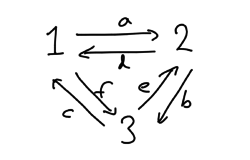Difference between revisions of "M(4,2,3)"
(Added image) |
|||
| Line 3: | Line 3: | ||
|image = M(4,2,3)quiver.png | |image = M(4,2,3)quiver.png | ||
|representative = <math>kA_4</math> | |representative = <math>kA_4</math> | ||
| − | |defect = <math>C_2 \times C_2</math> | + | |defect = [[C2xC2|<math>C_2 \times C_2</math>]] |
|inertialquotients = <math>C_3</math> | |inertialquotients = <math>C_3</math> | ||
|k(B) = 4 | |k(B) = 4 | ||
| Line 80: | Line 80: | ||
All irreducible characters have height zero. | All irreducible characters have height zero. | ||
| + | |||
| + | |||
| + | [[C2xC2|Back to <math>C_2 \times C_2</math>]] | ||
| + | |||
| + | [[Category: Morita equivalence classes|4,2,3]] | ||
| + | [[Category: Blocks with defect group C2xC2]] | ||
| + | [[Category: Tame blocks|4,2,3]] | ||
Revision as of 14:50, 31 August 2018
| Representative: | [math]kA_4[/math] |
|---|---|
| Defect groups: | [math]C_2 \times C_2[/math] |
| Inertial quotients: | [math]C_3[/math] |
| [math]k(B)=[/math] | 4 |
| [math]l(B)=[/math] | 3 |
| [math]{\rm mf}_k(B)=[/math] | 1 |
| [math]{\rm Pic}_k(B)=[/math] | [math](k^* \times k^* \times C_3):C_2[/math] |
| Cartan matrix: | [math]\left( \begin{array}{ccc} 2 & 1 & 1 \\ 1 & 2 & 1 \\ 1 & 1 & 2 \\ \end{array} \right)[/math] |
| Defect group Morita invariant? | Yes |
| Inertial quotient Morita invariant? | Yes |
| [math]\mathcal{O}[/math]-Morita classes known? | Yes |
| [math]\mathcal{O}[/math]-Morita classes: | [math]\mathcal{O}A_4[/math] |
| Decomposition matrices: | [math]\left( \begin{array}{ccc} 1 & 0 & 0 \\ 0 & 1 & 0 \\ 0 & 0 & 1 \\ 1 & 1 & 1 \\ \end{array}\right)[/math] |
| [math]{\rm mf}_\mathcal{O}(B)=[/math] | 1 |
| [math]{\rm Pic}_{\mathcal{O}}(B)=[/math] | [math]\mathcal{T}(B)=S_3[/math] |
| [math]PI(B)=[/math] | {{{PIgroup}}} |
| Source algebras known? | Yes |
| Source algebra reps: | [math]\mathcal{O}A_4[/math] |
| [math]k[/math]-derived equiv. classes known? | Yes |
| [math]k[/math]-derived equivalent to: | M(4,2,2) |
| [math]\mathcal{O}[/math]-derived equiv. classes known? | Yes |
| [math]p'[/math]-index covering blocks: | {{{coveringblocks}}} |
| [math]p'[/math]-index covered blocks: | {{{coveredblocks}}} |
| Index [math]p[/math] covering blocks: | {{{pcoveringblocks}}} |
Contents
Basic algebra
Quiver: a: <1,2>, b: <2,3> , c: <3,1>, d: <2,1>, e: <3,2>, f: <1,3>
Relations w.r.t. [math]k[/math]: ab=bc=ca=0, df=fe=ed=0, ad=fc, be=da, cf=eb
Other notatable representatives
Block number 2 of [math]k PSL_3(7)[/math] in the labelling used in [1]
Covering blocks and covered blocks
Let [math]N \triangleleft G[/math] with [math]p'[/math]-index and let [math]B[/math] be a block of [math]\mathcal{O} G[/math] covering a block [math]b[/math] of [math]\mathcal{O} N[/math].
If [math]b[/math] lies in M(4,2,3), then [math]B[/math] must lie in M(4,2,1) or M(4,2,3). For example consider blocks of [math]PSL_3(7) \triangleleft PGL_3(7)[/math].
If [math]B[/math] lies in M(4,2,3), then [math]b[/math] must lie in M(4,2,1) or M(4,2,3). For example consider the principal blocks of [math]O_2(A_4) \triangleleft A_4[/math].
Projective indecomposable modules
Labelling the simple [math]B[/math]-modules by [math]S_1, S_2, S_3[/math], the projective indecomposable modules have Loewy structure as follows:
[math]\begin{array}{ccc} \begin{array}{ccc} & S_1 & \\ S_2 & & S_3 \\ & S_1 & \\ \end{array}, & \begin{array}{ccc} & S_2 & \\ S_1 & & S_3 \\ & S_2 & \\ \end{array}, & \begin{array}{ccc} & S_3 & \\ S_1 & & S_2 \\ & S_3 & \\ \end{array} \end{array} [/math]
Irreducible characters
All irreducible characters have height zero.
